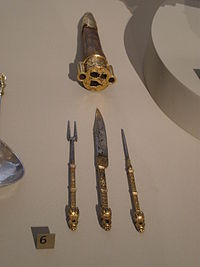- Cutlery
-
Cutlery refers to any hand implement used in preparing, serving, and especially eating food in the Western world. It is more usually known as silverware or flatware in the United States, where cutlery can have the more specific meaning of knives and other cutting instruments. This is probably the original meaning of the word. Since silverware suggests the presence of silver, the term tableware has come into use.
The major items of cutlery in the Western world are the knife, fork and spoon. In recent times, utensils have been made combining the functionality of pairs of cutlery, including the spork (spoon / fork), spife (spoon / knife), and knork (knife / fork) or the sporf which is all three.
Contents
Etymology
The word cutler derives from the Middle English word 'cuteler' and this in turn derives from Old French 'coutelier' which comes from 'coutel'; meaning knife (modern French: couteau).[1]
Composition
Traditionally, good quality cutlery was made from silver (hence the U.S. name), though steel was always used for more utilitarian knives, and pewter was used for some cheaper items, especially spoons. From the nineteenth century, electroplated nickel silver (EPNS) was used as a cheaper substitute; nowadays, most cutlery, including quality designs, is made from stainless steel. Another alternative is melchior, a nickel and copper alloy, which can also sometimes contain manganese. It also contains elements of magnesium and copper sulphate.
Plastic cutlery is made for disposable use, and is frequently used outdoors (camping, excursions, and BBQs for instance), at fast-food or take-away outlets, or provided with airline meals.
History
The first documented use of the term "cutler" in Sheffield appeared in a 1297 tax return. A Sheffield knife was listed in the King's possession in the Tower of London fifty years later. Several knives dating from the 14th century are on display at the Cutlers' Hall in Sheffield.[1]
Cutlery has been made in many places. In Britain the industry became concentrated by the late 16th century in and around Birmingham and Sheffield. However, the Birmingham industry increasingly concentrated on swords, made by "long cutlers", and on other edged tools, whereas the Sheffield industry concentrated on knives.
At Sheffield the trade of cutler became divided, with allied trades such as razormaker, awlbladesmith, shearsmith and forkmaker emerging and becoming distinct trades by the 18th century.
Before the mid 19th century when cheap mild steel became available due to new methods of steelmaking, knives (and other edged tools) were made by welding a strip of steel on to the piece of iron that was to be formed into a knife, or sandwiching a strip of steel between two pieces of iron. This was done because steel was then a much more expensive commodity than iron. Modern blades are sometimes laminated, but for a different reason. Since the hardest steel is brittle, a layer of hard steel may be laid between two layers of a milder, less brittle steel, for a blade that keeps a sharp edge well, and is less likely to break in service.
After fabrication, the knife had to be sharpened, originally on a grindstone, but from the late medieval period in a blade mill or (as they were known in the Sheffield region) a cutlers wheel.
Manufacturing centers
Traditional centers of cutlery-making include:
- Sheffield in the United Kingdom
- Solingen in Germany
- Thiers and Laguiole in France
- Albacete in Spain
- Wazirabad in Pakistan
See also
- Tableware
- List of eating utensils
- List of food preparation utensils
- Silver (household)
- Table setting
References
For Sheffield:
- ^ a b The Sheffield Knife Book, Geoffrey Tweedale, The Hallamshire press, 1996, ISBN 1-874718-11-3
- Hey, D. The Fiery Blades of Hallamshire: Sheffield and Its Neighbourhood, 1660–1740 (Leicester University Press 1991). 193–140.
- Lloyd, G. I. H. The Cutlery Trades: An Historical Essay in the Economics of Small Scale Production. (1913; repr. 1968).
External links
- American Bladesmith Society
- Flatware Patterns at antiquesilverspoons.co.uk
- Associazione culturale Coltellinai Forgiatori Bergamaschi - Research laboratory on damascus steel
Categories:- Eating utensils
Wikimedia Foundation. 2010.



